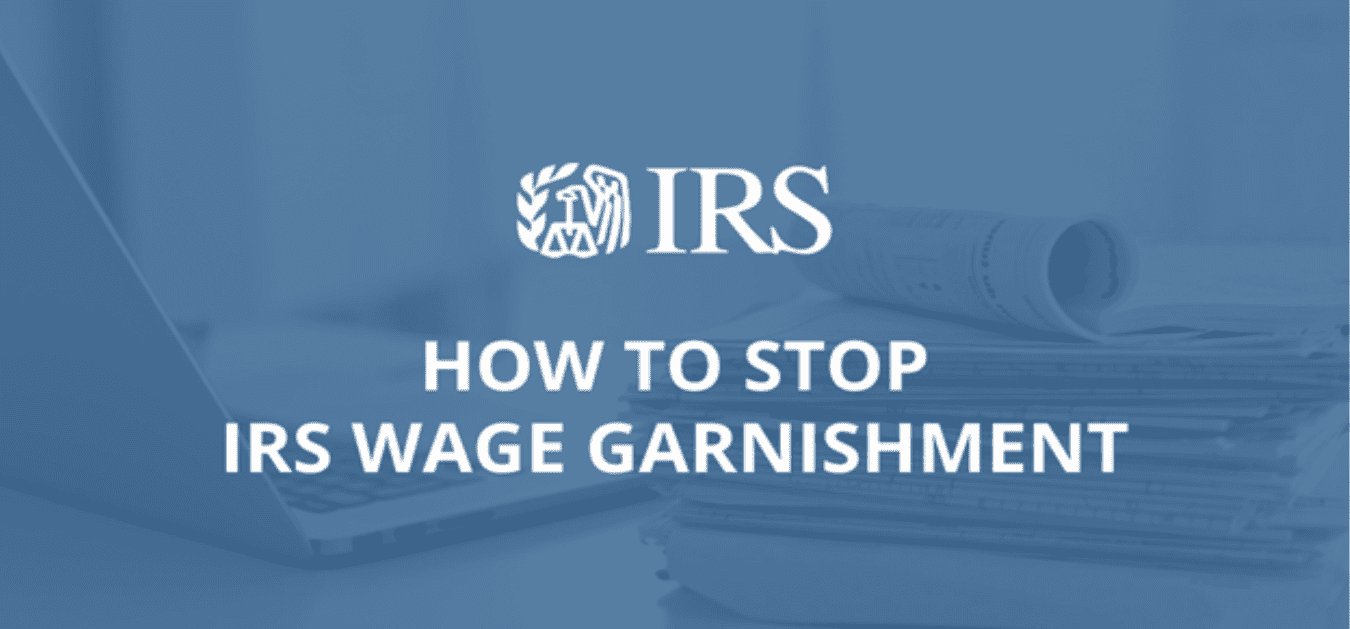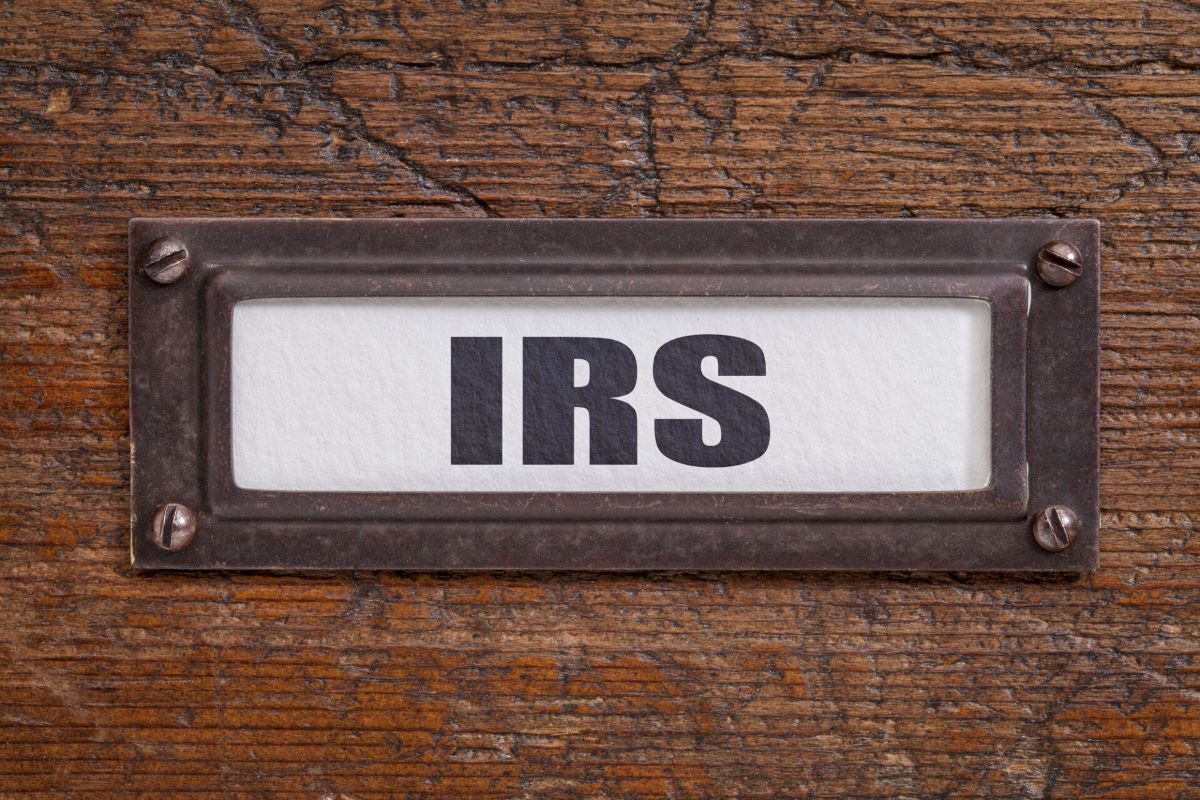

Finance
How To Stop IRS Wage Garnishment
Published: October 30, 2023
Learn the step-by-step process to stop IRS wage garnishment and regain control of your finances. Expert advice and effective strategies for resolving your tax issues.
(Many of the links in this article redirect to a specific reviewed product. Your purchase of these products through affiliate links helps to generate commission for LiveWell, at no extra cost. Learn more)
Table of Contents
Introduction
Dealing with the Internal Revenue Service (IRS) can be a daunting experience, especially when faced with the prospect of wage garnishment. If you owe back taxes or have unresolved tax issues, the IRS has the authority to take a portion of your paycheck directly from your employer to satisfy your tax debt. This process, known as wage garnishment, can have a significant impact on your financial well-being and make it challenging to meet your everyday expenses.
However, it is important to remember that you have options when it comes to stopping IRS wage garnishment. By familiarizing yourself with the available strategies and taking appropriate action, you can regain control of your financial situation and resolve your tax issues.
In this article, we will explore various methods you can use to stop IRS wage garnishment and alleviate the financial burden it brings. From understanding the process of wage garnishment to seeking professional assistance, we will provide you with practical advice to help you navigate through this challenging situation.
While it is recommended to consult with a tax professional or an attorney for personalized guidance, this article aims to provide you with a general understanding of the steps you can take to halt IRS wage garnishment. By empowering yourself with knowledge, you can take proactive measures to protect your income and find a resolution with the IRS.
Understanding IRS Wage Garnishment
IRS wage garnishment is a legal process through which the IRS can collect unpaid taxes by directly withholding a portion of your wages. If you owe back taxes or have unresolved tax debts, the IRS may issue a wage garnishment order to your employer, directing them to withhold a certain amount from each of your paychecks until the debt is satisfied.
It is important to note that the IRS has strict guidelines regarding wage garnishment. Under federal law, the IRS can typically garnish up to 25% of your disposable income. Disposable income refers to the amount you have left after deducting taxes and other mandatory payroll deductions.
Before initiating wage garnishment, the IRS will typically send you several notices to inform you of your unpaid tax liabilities and provide an opportunity to resolve the issue. These notices, such as the Notice of Intent to Levy or Levy Notice, serve as warnings that the IRS is taking steps to collect the outstanding debt. Ignoring or delaying action in response to these notices can ultimately lead to wage garnishment.
One crucial point to understand is that wage garnishment is not a one-time event but rather an ongoing process. It continues until the tax debt is fully paid off, you reach a resolution with the IRS, or you take appropriate action to stop the garnishment.
IRS wage garnishment can have a significant impact on your financial situation. It can make it challenging to meet your everyday living expenses, pay your bills, and maintain a decent standard of living. Additionally, wage garnishment can negatively affect your credit score and make it difficult to secure loans or obtain credit in the future.
It is essential to address wage garnishment as soon as possible to avoid further financial hardship and seek a resolution with the IRS. In the next sections, we will explore various strategies you can implement to stop IRS wage garnishment and regain control of your finances.
Assessing the Financial Impact
Before taking action to stop IRS wage garnishment, it is crucial to assess the financial impact it is having on your overall financial situation. Understanding the extent of the garnishment and its implications will allow you to develop a suitable plan of action.
Start by reviewing your pay stubs and calculating the amount that is being withheld from each paycheck as a result of the wage garnishment. Take into account both the actual dollar amount and the percentage of your income that is being garnished. This will give you a clear picture of how much money you have left to cover your essential expenses.
Next, create a comprehensive list of your monthly expenses, including rent or mortgage payments, utilities, groceries, transportation costs, and any other necessary expenses. Compare this list to the amount of income after the garnishment to determine if you have enough funds to cover your essential needs.
If you find that the wage garnishment is causing significant financial strain and making it difficult for you to meet your basic living expenses, it is important to take immediate action to stop the garnishment.
Consider reviewing your financial situation to identify any areas where you can reduce expenses or find additional sources of income. This may involve cutting unnecessary expenses, negotiating with creditors for lower payments, or exploring opportunities for extra work or side gigs.
Additionally, take into account any other outstanding debts or financial obligations you may have. If you are struggling with multiple debts, it may be beneficial to consider seeking professional advice from a credit counseling agency or a financial advisor who can help you navigate your overall financial situation.
By assessing the financial impact of the wage garnishment, you can gain a better understanding of your current financial standing and make informed decisions on the best course of action to stop the garnishment and regain control of your finances.
Gathering Necessary Documents
When dealing with IRS wage garnishment, it is important to gather all the necessary documents to support your case and effectively communicate with the IRS. Having the appropriate documentation ready will help you present your financial situation more accurately and increase your chances of stopping the garnishment.
Here are some essential documents you should gather:
- Income Documents: Collect recent pay stubs or income statements from your employer. These documents will help the IRS understand your current income and determine the appropriate amount that should be withheld, if any, to satisfy your tax debt.
- Bank Statements: Obtain copies of your bank statements for the past few months. These statements will provide a clear picture of your financial transactions and can be used to demonstrate your income, expenses, and any other financial obligations you have.
- Tax Returns and Notices: Retrieve copies of your tax returns for the years in question. Review any notices or correspondence you have received from the IRS regarding your tax debt. These documents will give you insights into the specific issues the IRS has identified and allow you to respond accordingly.
- Expense Documentation: Compile supporting documentation for your monthly expenses. This may include rent or mortgage payments, utility bills, grocery receipts, transportation costs, and any other necessary expenses. Having accurate information about your essential expenses will help demonstrate to the IRS that a wage garnishment is causing significant financial hardship.
- Financial Hardship Documents: If you are facing financial hardship due to the wage garnishment, gather supporting documents to substantiate your claim. This can include medical bills, evidence of unemployment or reduced income, or any other documentation that validates your inability to meet your basic living expenses.
It is vital to keep copies of all the documents you gather and organize them in a logical manner. This will provide you with easy access to the information you need when communicating with the IRS or seeking professional assistance.
Having the necessary documents ready will also enable you to respond promptly to requests from the IRS and demonstrate your commitment to resolving your tax debt. By presenting a clear and well-documented case, you increase your chances of reaching a favorable outcome and stopping the wage garnishment.
Communicating with the IRS
Effective communication with the IRS is crucial when it comes to stopping wage garnishment. By maintaining open and clear lines of communication, you can present your case, address any concerns, and negotiate a resolution that is fair and manageable.
Here are some key points to keep in mind when communicating with the IRS:
- Respond promptly: It is essential to respond promptly to any notices or correspondence you receive from the IRS. Ignoring or delaying your response can result in further escalation of the wage garnishment process. Be sure to carefully review each communication and take appropriate action within the specified timeframe.
- Document everything: Keep a record of all communication with the IRS, including letters, emails, and phone conversations. Note down the dates, names of the IRS representatives you speak with, and the details of the conversation. This documentation can be valuable if you need to reference any information or resolve any discrepancies in the future.
- Stay polite and professional: Maintain a courteous and professional tone when communicating with the IRS, even if you feel frustrated or overwhelmed. Remember, the IRS agents are doing their job, and being respectful can help establish a more cooperative and productive relationship.
- Provide accurate information: When corresponding with the IRS, ensure that you provide accurate and complete information. Double-check your statements, calculations, and supporting documentation to minimize any potential misunderstandings. Providing precise and factual information will strengthen your case and increase your credibility.
- Explain your financial hardship: If the wage garnishment is causing significant financial hardship, clearly explain your situation to the IRS. Provide supporting documentation, such as bank statements, expense records, and any other proof of financial difficulties. Demonstrating your inability to meet basic living expenses can help make a case for a more favorable resolution.
- Consider professional representation: If you find it challenging to communicate effectively with the IRS or navigate the complex tax laws, you may want to consider hiring a tax professional or an attorney. These professionals have experience in dealing with the IRS and can provide expert guidance to help you stop the wage garnishment and resolve your tax debt.
Remember, open and honest communication is essential to finding a resolution with the IRS. By maintaining clear lines of communication and presenting your case effectively, you can increase the likelihood of stopping the wage garnishment and finding a fair resolution to your tax debt.
Submitting an Offer in Compromise
If you are unable to pay your tax debt in full, you may consider submitting an Offer in Compromise (OIC) to the IRS. An OIC is a settlement agreement between you and the IRS that allows you to pay a reduced amount to resolve your tax debt.
Here are the key steps in submitting an Offer in Compromise:
- Evaluate your eligibility: Not everyone qualifies for an Offer in Compromise. The IRS considers various factors such as your income, expenses, asset equity, and future earning potential to determine your eligibility. You can use the IRS Offer in Compromise Pre-Qualifier tool on the IRS website to assess your eligibility.
- Complete the necessary forms: The IRS requires specific forms to be completed when submitting an Offer in Compromise. The main form is Form 656, Offer in Compromise. This form requires you to provide detailed financial information, including your assets, liabilities, and income. Make sure to complete the form accurately and attach all required supporting documentation.
- Submit the offer and pay the application fee: Once you have completed the necessary forms, submit your Offer in Compromise package to the IRS. Along with the offer, you will need to pay a non-refundable application fee, which can vary depending on your financial situation. The IRS may consider waiving the fee if you meet specific income criteria.
- Wait for IRS review: After you submit your Offer in Compromise, the IRS will review your application along with the supporting documentation. This review process can take several months, so it is important to be patient. During this time, continue making any required payments and timely file your tax returns.
- Negotiate with the IRS: If the IRS determines that your offer is appropriate, they will work with you to finalize the details of the agreement. At this stage, you may have the opportunity to negotiate the amount you will pay and the terms of the settlement. It is crucial to carefully review any proposed terms and ensure you understand the implications before accepting the offer.
- Comply with the terms of the agreement: Once your Offer in Compromise is accepted, it is crucial to comply with the terms of the agreement. This typically involves making the agreed-upon payments within the specified timeframe and staying in compliance with all future tax obligations for a specific period. Failure to meet these obligations can result in the reinstatement of the original tax debt.
Submitting an Offer in Compromise can be a complex process, and it is advisable to seek professional assistance from a tax professional or an attorney who specializes in tax debt resolution. These professionals can guide you through the process, help determine your eligibility, and increase your chances of a successful OIC.
Keep in mind that an Offer in Compromise is not guaranteed to be accepted, and the IRS will assess and evaluate your financial situation thoroughly. However, if approved, it can provide a significant opportunity to settle your tax debt and stop wage garnishment.
Negotiating a Payment Plan
If paying off your tax debt in full or submitting an Offer in Compromise is not a viable option for you, negotiating a payment plan with the IRS can provide a more manageable solution to stop wage garnishment and resolve your tax debt over time.
Here are the essential steps to negotiate a payment plan:
- Assess your ability to make payments: Evaluate your current financial situation and determine how much you can afford to pay towards your tax debt each month. Consider your income, expenses, and any other financial responsibilities. This assessment will help you determine a realistic payment amount.
- Contact the IRS: Reach out to the IRS to request a payment plan. You can do this by calling the phone number provided on your IRS notices or by using the Online Payment Agreement tool on the IRS website. Be prepared to provide your financial information and explain your circumstances.
- Choose the right payment plan: The IRS offers various payment plan options, including short-term payment plans and long-term installment agreements. The appropriate plan will depend on the amount you owe and your ability to pay. The IRS will work with you to determine the best payment plan based on your financial situation.
- Submit the necessary forms: Depending on the payment plan you choose, you may need to complete and submit certain forms to the IRS. This may include Form 9465, Installment Agreement Request, or Form 433-F, Collection Information Statement. Make sure to fill out the forms accurately and include all required documentation.
- Make timely payments: Once your payment plan is approved, it is crucial to make your monthly payments on time. Late or missed payments can result in penalties and may lead to the reinstatement of wage garnishment. Set up a reminder system to ensure you do not miss any payments and stay in compliance with the agreement.
- Reevaluate your payment plan if necessary: If your financial situation changes and you are no longer able to maintain the agreed-upon payment plan, contact the IRS to discuss possible modifications. The IRS may be willing to adjust the payment amount or explore alternative options based on your updated financial circumstances.
When negotiating a payment plan, it is important to be honest and transparent with the IRS about your financial situation. Providing accurate information and demonstrating your willingness to fulfill your tax obligations will help establish a more favorable outcome.
Depending on the complexity of your tax debt, it may be beneficial to seek professional advice from a tax professional or an attorney who can assist you in negotiating a payment plan that works best for your unique circumstances.
By negotiating a payment plan with the IRS, you can stop wage garnishment and gradually pay off your tax debt while maintaining financial stability.
Requesting an Installment Agreement
If you are unable to pay off your tax debt in a lump sum or through an Offer in Compromise, another option to stop wage garnishment is to request an installment agreement with the IRS. An installment agreement allows you to pay off your tax debt in monthly installments over a specified period of time.
Here are the essential steps to request an installment agreement:
- Evaluate your financial situation: Assess your income, expenses, and ability to make monthly payments towards your tax debt. Consider your essential living expenses and determine how much you can reasonably afford to pay each month without causing significant financial hardship.
- Contact the IRS: Reach out to the IRS to request an installment agreement. You can do this by calling the phone number provided on your IRS notices or by using the Online Payment Agreement tool on the IRS website. Be prepared to provide your financial information and explain your circumstances.
- Choose the appropriate installment agreement: The IRS offers different types of installment agreements depending on the amount you owe and the timeframe within which you can pay. These include guaranteed, streamlined, and regular installment agreements. Work with the IRS to determine the best agreement for your situation.
- Complete the necessary forms: Depending on the type of installment agreement, you may need to complete and submit certain forms to the IRS. This may include Form 9465, Installment Agreement Request, or Form 433-F, Collection Information Statement. Fill out the forms accurately and include all required documentation.
- Make timely payments: Once your installment agreement is approved, it is crucial to make your monthly payments on time. Late or missed payments can result in penalties and may lead to the reinstatement of wage garnishment. Set up a reminder system to ensure you do not miss any payments and stay in compliance with the agreement.
- Reevaluate your installment agreement if necessary: If your financial situation changes and you are no longer able to meet the agreed-upon monthly payments, contact the IRS to discuss possible modifications. The IRS may be willing to adjust the payment amount or consider alternative options based on your updated financial circumstances.
When requesting an installment agreement, it is essential to provide accurate and honest information to the IRS. Be transparent about your financial situation and demonstrate your commitment to fulfilling your tax obligations. This will help establish a more favorable outcome in securing an installment agreement that aligns with your ability to pay.
Consider seeking professional advice from a tax professional or an attorney if you need assistance in requesting an installment agreement. They can guide you through the process, help you navigate the IRS requirements, and increase your chances of securing an agreement that is suitable for your financial situation.
By requesting an installment agreement, you can stop wage garnishment and gradually pay off your tax debt in a manageable and structured manner.
Exploring Innocent Spouse Relief
If you are facing wage garnishment due to tax debts that are solely the responsibility of your spouse or former spouse, you may be eligible for Innocent Spouse Relief. This is a provision offered by the IRS that can release you from the liability of your spouse’s tax debts and potentially stop wage garnishment.
Here are the key points to consider when exploring Innocent Spouse Relief:
- Evaluate your eligibility: To qualify for Innocent Spouse Relief, you must meet certain criteria set by the IRS. This includes demonstrating that you filed a joint tax return with your spouse or ex-spouse, that there was an understatement or a misallocation of tax on the return, and that you had no knowledge or reason to know about it at the time of filing.
- Understand the types of relief available: The IRS offers three types of Innocent Spouse Relief: Classic Innocent Spouse Relief, Separation of Liability Relief, and Equitable Relief. Each type has specific requirements and conditions. It is important to review them carefully and determine which one applies to your situation.
- Gather supporting documentation: To support your Innocent Spouse Relief claim, gather all relevant documents that demonstrate your lack of knowledge or involvement in the tax discrepancy. This may include financial records, communications, or any documentation that proves you had no involvement or benefit from the understated taxes.
- Complete and submit Form 8857: To request Innocent Spouse Relief, you need to complete Form 8857, Request for Innocent Spouse Relief. Provide complete and accurate information on the form and attach any supporting documentation. Submit the form to the IRS within the appropriate timeframe based on your circumstances.
- Wait for IRS review and decision: Once you submit your request, the IRS will review your claim and the supporting documentation. This review process can take several months, so be patient. The IRS will inform you of their decision regarding your Innocent Spouse Relief claim.
- Seek professional assistance if needed: If you are unsure about your eligibility for Innocent Spouse Relief or need assistance with the application process, consider consulting a tax professional or an attorney who specializes in tax debt relief. They can guide you through the process and help increase your chances of a successful claim.
Innocent Spouse Relief can be a valuable option to stop wage garnishment when you are not responsible for your spouse’s or ex-spouse’s tax debts. Be sure to carefully review the IRS guidelines and consult with a professional to determine if Innocent Spouse Relief is appropriate for your situation.
Keep in mind that the approval of Innocent Spouse Relief is at the discretion of the IRS. Providing strong evidence and meeting the eligibility criteria will increase the likelihood of stopping wage garnishment and relieving yourself from the tax liabilities of your spouse or ex-spouse.
Seeking Professional Assistance
Dealing with IRS wage garnishment and resolving tax debt can be complex and overwhelming. If you find yourself struggling to navigate the process on your own, seeking professional assistance can provide you with valuable guidance and support.
Here are the reasons why you may benefit from seeking professional assistance:
- Expertise and Knowledge: Tax professionals, such as enrolled agents, certified public accountants (CPAs), or tax attorneys, have in-depth knowledge of tax laws and regulations. They understand the complexities of the tax system and can provide you with expert guidance tailored to your specific situation.
- Personalized Advice: A tax professional can assess your financial situation, review your tax records, and provide personalized advice based on your unique circumstances. They can help you understand the available options to stop wage garnishment and guide you through the steps necessary to resolve your tax debt.
- Negotiation Skills: Dealing directly with the IRS can be intimidating. A tax professional can act as your representative and negotiate with the IRS on your behalf. They can effectively communicate your financial situation, present your case, and explore possible resolutions to stop wage garnishment.
- Documentation and Application Assistance: Tax professionals can assist you in gathering the necessary documentation, completing the required forms accurately, and submitting the appropriate paperwork to the IRS. They understand the intricacies of the application process and can help ensure that all relevant information is included.
- Representation in Audits or Appeals: If your tax situation involves an audit or an appeal, a tax professional can provide you with representation and guidance throughout the process. They can help you navigate the complexities of the audit or appeal and advocate for your best interests.
- Peace of Mind: By engaging a tax professional, you can have peace of mind, knowing that you have an experienced professional handling your case. This can alleviate stress and allow you to focus on other important aspects of your life while working towards resolving your tax debt.
It is important to note that seeking professional assistance comes at a cost. However, the potential benefits, such as stopping wage garnishment and finding a resolution for your tax debt, often outweigh the associated fees. Consider the potential long-term financial impact of your tax situation when deciding whether to seek professional assistance.
When choosing a tax professional, research their credentials, qualifications, and expertise in tax debt resolution. Look for professionals who have experience dealing with IRS wage garnishment cases and can provide references or testimonials from satisfied clients.
Remember, a tax professional should work with your best interests in mind and help you navigate the complexities of resolving your tax debt and stopping wage garnishment.
Conclusion
Dealing with IRS wage garnishment can be financially stressful and emotionally draining. However, there are several strategies you can implement to stop wage garnishment and regain control of your financial situation. By understanding the process, assessing the financial impact, and taking appropriate action, you can find a resolution for your tax debt and alleviate the burden of wage garnishment.
Whether you choose to submit an Offer in Compromise, negotiate a payment plan, explore Innocent Spouse Relief, or seek professional assistance, it is crucial to take proactive steps towards resolving your tax debt. Each option comes with its own requirements and considerations, so it is important to assess your financial situation, gather necessary documentation, and communicate effectively with the IRS.
Remember, the journey to stopping wage garnishment may require patience and perseverance. It is important to stay organized, keep track of communications, and comply with any agreements or resolutions reached. In some cases, seeking professional assistance from a tax professional or an attorney can provide valuable expertise and guidance throughout the process.
By taking action and exploring the available options, you can stop wage garnishment and regain control of your finances. The key is to stay informed, be proactive, and seek the necessary support to navigate the complexities of resolving your tax debt.
While the information provided in this article can serve as a general guide, it is important to remember that tax situations can vary greatly. It is advisable to consult with a tax professional or an attorney who can provide personalized advice based on your specific circumstances.
Remember, you have the power to take control of your tax debt and stop IRS wage garnishment. Stay informed, seek assistance if needed, and take the necessary steps to find a resolution. With the right strategy and determination, you can overcome the challenges of wage garnishment and achieve financial freedom.














